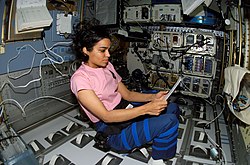Kalpana Chawla
| Kalpana Chawla कल्पना चावला | |
 | |
| NASA-astronaut | |
|---|---|
| Född | 17 mars 1962 Karnal, Indien |
| Död | 1 februari 2003 (41 år) |
| Tid i rymden | 31 dagar, 14 timmar, 54 minuter |
| Urvalsgrupp | Astronautgrupp 15 |
| Uppdrag | STS-87, STS-107 |
| Uppdragsemblem | |
| Utmärkelser | |

Kalpana Chawla (Hindi: कल्पना चावला), född 1 juli 1961 i Karnal i Indien, död 1 februari 2003 ovanför Texas, var en amerikansk astronaut uttagen i astronautgrupp 15 den 9 december 1994. Hon deltog med STS-107 16 januari–1 februari 2003, när alla sju astronauterna ombord förolyckades under återinträdet i jordens atmosfär.[1]
Kalpana Chawlas intresse för att flyga var inspirerat av Jehangir Ratanji Dadabhoy Tata, en indisk flygpionjär.
Eftermäle
2004 tilldelades hon Congressional Space Medal of Honor.
2006 namngavs månkratern Chawla efter henne, kratern är belägen i Apollokratern på månens baksida.
Även asteroiden 51826 Kalpanachawla och Northrop Grumman:s rymdfarkost Cygnus NG-14 är uppkallade efter henne.[2]
Utbildning och tidig yrkeserfarenhet
År 1976 utexaminerades hon från Tagoreskolan i Karnal. 1982 avlade hon Bachelor of Science-examen i flygteknik vid Punjab Engineering College. 1982 flyttade hon till USA där hon avlade Master of Science-examen i flygteknik från University of Texas i Arlington år 1984. Därefter flyttade hon till Boulder och avlade 1988 en doktorsexamen i flygteknik vid University of Colorado Boulder. 1988 började Chawla arbeta på NASA Ames Research Center inom området Computational fluid dynamics.[1]
Familjeliv
Kalpana Chawla gifte sig med den franske frilansflyginstruktören Jean-Pierre Harrison 1983 och blev amerikansk medborgare 1990.
Rymdfärder
Rymdfärdsstatistik
| Färd | Datum | Tid | EVA |
|---|---|---|---|
| STS-87 | 19 november - 5 december 1997 | 376:34:00 | 0:00:00 |
| STS-107 | 16 januari - 1 februari 2003 | 382:20:00 | 0:00:00 |
| Totalt | 758:54:00 | 0:00:00 | |
Externa länkar
 Wikimedia Commons har media som rör Kalpana Chawla.
Wikimedia Commons har media som rör Kalpana Chawla.
Källor
”Biographical Data” (på engelska) (PDF). NASA. maj 2004. https://www.nasa.gov/wp-content/uploads/2020/09/chawla_kalpana.pdf?emrc=b7b7dd. Läst 11 maj 2024.
- ^ [a b] Probst, Ernst (2010). ”Kalpana Chawla” (på tyska). Frauen im Weltall. GRIN Verlag. sid. 9
- ^ ”Minor Planet Center 51826 Kalpanachawla” (på engelska). Minor Planet Center. https://www.minorplanetcenter.net/db_search/show_object?object_id=51826. Läst 7 september 2018.
Media som används på denna webbplats
The STS-87 patch is shaped like a space helmet symbolizing the Extravehicular Activity (EVA) on the mission in support of testing of tools for the assembly of the International Space Station (ISS). Earth is shown reflected on the backside of the helmet. The Space Shuttle Columbia forms the interface between the Earth and the heavens, the back and front sides of the helmet in profile. The three red lines emerging from Columbia represent the astronaut symbol as well as the robot arm, which was used to deploy and retrieve the Spartan satellite.
The text 'µg' represents the payloads studying microgravity science in space on this United States Microgravity Payload (USMP-4) mission. Gold flames outlining the helmet visor represent the corona of the Sun, which will be studied by Spartan. The flag of Ukraine is next to the name of the payload specialist who is the first person from that nation to fly on the Space Shuttle.
Astronaut Kalpana Chawla (1961 † 2003), STS-107 mission specialist, looks over a procedures checklist in the SPACEHAB Research Double Module aboard the Space Shuttle Columbia.
Kalpana Chawla, American astronaut who died during the failed re-entry of Space Shuttle Columbia.
STS107-S-001 (May 2001) This is the insignia for w:STS-107, which is a multi-discipline microgravity and Earth science research mission with a multitude of international scientific investigations conducted continuously during the planned 16 days on orbit. The central element of the patch is the microgravity symbol, µg, flowing into the rays of the astronaut symbol. The mission inclination is portrayed by the 39 degree angle of the astronaut symbol to the Earth's horizon. The sunrise is representative of the numerous experiments that are the dawn of a new era for continued microgravity research on the International Space Station and beyond. The breadth of science conducted on this mission will have widespread benefits to life on Earth and our continued exploration of space illustrated by the Earth and stars. The constellation Columba (the dove) was chosen to symbolize peace on Earth and the Space Shuttle Columbia. The seven stars also represent the mission crew members and honor the original astronauts who paved the way to make research in space possible. The Israeli flag is adjacent to the name of the payload specialist who is the first person from that country to fly on the Space Shuttle.




